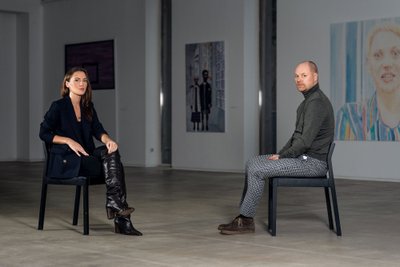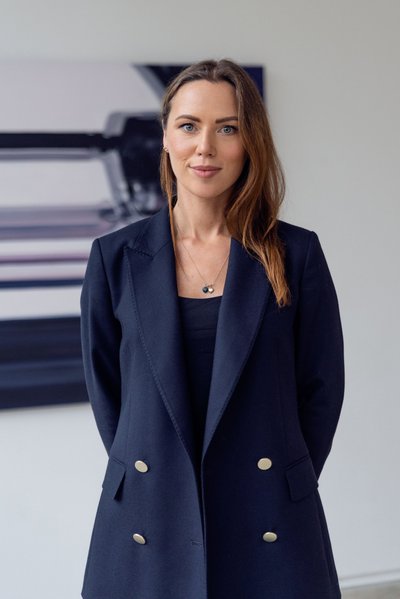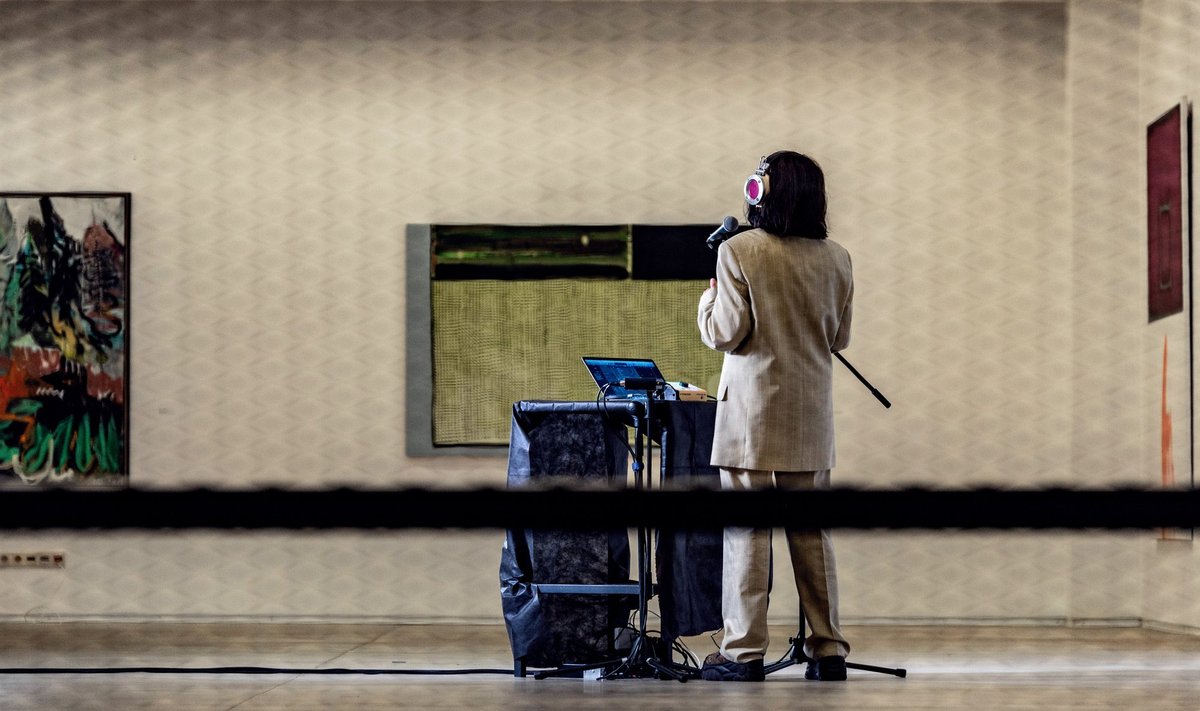This project is focused solely on artists under 30 years old from all disciplines who have acquired (or are in the process of acquiring) a diploma in art. The age limit has been imposed deliberately as the organisers wish to concentrate only on those very young artists who have just graduated (or are graduating) universities and have not yet had the opportunity to appear in public. This category of young artists is most vulnerable and has the largest need for support.
This year, for the 12th time already, the organisers of the Young Painter Prize Award – the art theorist Julija Dailidėnaitė and the painter Vilmantas Marcinkevičius – invite the audiences to appreciate the works of the young artists from Lithuania, Latvia and Estonia. This time the event was different from usual because the YPP Award winner has been announced via an online stream from the creative industry centre "Pakrantė" which was supposed to host the opening of the show with the works of the finalists.
In this interview, the organisers share their thoughts on the challenges posed by the quarantine, the YPP awardee art collection, the competitive selection process, and, last but not least, their plans for the future.
VV: What comes to your mind when you think about both the nomination and show opening having had to be held under the conditions of social distancing? Have you ever considered such a scenario before?
JD: we all have to face up to the new life and adjust to the circumstances dictated by the fluctuating infection numbers of the COVID-19 pandemic. This year has been extremely challenging for everybody, particularly the culture sector. Visual arts event without an audience?... This does sound a bit macabre. Traditionally accompanied with live music and debates, the closing event of the Young Painter Prize project was particularly affected.

From the very start of the pandemic, I had this nagging idea that we should perhaps have a break this year and abstain from forcing the event. But then I realised that this was exactly the time when we should all help each other survive the consequences of our 'suspended' lives. I am very happy that we launched the project this year. Until the very last moment I was hoping that we will be able to have a live event. However, the quarantine has been reinstated a week before the YPP award ceremony, and we had to make do with what we had. Our impromptu video stream from an empty exhibition hall turned out to be a complete success – it was watched by 11,643 viewers from all over the world!
VM: We didn't even think about this during the summer, but, apparently, everything was pointing in that direction. We didn't know how things would turn out until the last minute. But, thanks to Julija and the whole team, the event was a success. The audience was absent, but the artworks, ignorant of the pandemic, spoke for themselves. They were there, and we're happy that we were able to display them at "Pakrantė". These days, both theatre shows and sports events take place in empty halls too – this is how reality and virtuality overlap. For instance, "Mona Lisa" can only be viewed through a thick layer of glass, yet this does not diminish its realness. We look at the artworks of the YPP finalists through the layer of glass as well, which turns the show into a giant aquarium.
VV: This year's prize involves a two-month residency at "SIM" in Reykjavik, 2,000 Euro cash prize, and the opportunity to hold two solo shows – one in "Pamėnkalnis" gallery, Lithuania, and the other one in "galleri NB", Denmark. But, perhaps, the most significant part of the prize is that the winner's artwork will be the inclusion of the winner's artwork in the Lithuanian National Art Museum's Painting Collection which is currently housed in the National Art Gallery. When did you come up with this marvellous initiative? And what does it mean to a young artist?
JD: The project was launched in 2009, in the wake of the global economical crisis.
Back then, the situation that the young artists found themselves in was radically different from what we have today: the galleries were not as willing to work with the unknown young creatives, and the funding organisations were not as generous. Meanwhile we were driven by the desire to help the up-and-coming artists, but we didn't yet know how to make it happen because we had no such precedents neither in Lithuania, nor in our neighbouring countries.
At the beginning we didn't have a clear plan for the YPP artwork collection, but we decided that the winners' artworks should stay with the organisers. We started with passing the artworks to our patrons as a reward for their support. A few years later, we realised that the project was appreciated and even necessary. With the strong support from our patrons behind our backs, we decided to turn our competition into a continous anual event, and collect the winners' artworks with the aim of passing them on to some Lithuanian museum some day.
In 2018, during our ten year anniversary, after some debates among ourselves and with the YPP patrons, we finally decided to donate our collection to the Lithuanian Art Museum. I think this still is a rather modest gift as far as our national painting collections are concerned, but it certainly is a significant incentive for an up-and-coming artist. 'The artwork is stored in the Lithuanian Art Museum' – every artist aims at having such an honourable record in their creative portfolio.
VM: This initiative got established only during the tenth year of the YPP project. Until then, we didn't have the opportunity to donate their artworks to the Lithuanian National Art Museum. The record of all the YPP-related publications, press reviews, and solo shows in the artist biographies became a sign of recognition for the YPP as a whole.
So, the YPP winners' artworks were moved to the Lithuanian Art Museum, which coincided with our ten-year anniversary. Today, the painting by our first YPP winner Andrius Zakarauskas is on a permanent display there. As an artist, I consider this to be the greatest prize one can receive. Many artists seek recognition and acknowledgement, and what can be better than having your artwork on a museum display? However, young artists write their names into the art history somewhat in advance because nobody knows what turns their careers will make. We can never know what might happen – today we even have artists that are no longer with us. Among them – the 2011 YPP winner Jonas Jurcikas. But that's life – it cannot be planned for decades ahead.

Nonetheless, the YPP winners are appreciated at the highest level. Until now they didn't have such an opportunity and had to shape their careers on their own. One of the perks of YPP is that the art of the young ones is seen by a jury of professionals who are free to have their own insights and views. Therefore YPP is a sort of a shortcut towards public exposure.
VV: The importance of a collaboration between the painter and curator. What do you think about this tandem?
JD: Loyalt is the trait I highly respect and promote. Trust and collaboration are two main aspects that determine the success of evey relationship not only within couples and families, but also between gallerists and artists, or between collectors and art dealers.
VM: The collaboration between curator and artist should generate debates and artistic analyses. Today artists are expected to present their ideas not only visually but in writing too. Although, in my view, this shouldn't be obligatory – after all, there can be many ways to make an artwork. Curator's collaborative role is important and useful, particularly during the group shows and the development of new themes. Surely an artist would also benefit from the art theorist's insights too – they can help with the creative navigation. I see no confrontation in such a union. Back in the day, we used to be told to 'let art speak for itself', but today this view is no longer popular. Now we have many people who want and can talk about art, which can only be a good thing.
VV: During one of your interviews you have mentioned that the work of young artists is highly self-reflective, although they rarely touch upon the topics of politics or climate change. Why do you think this is the case?
JD: I think painting can and is ready to talk about these things, and we see many examples of this all over the world.
Although, in my comment, I was talking about the range of works within the YPP project – they are created by rather young artists (YPP has the age limit of 30 years) who are still searching for their expressive language and their sets of themes. You must agree that, without a more substantial experience in life, young artists are not ready to tackle complicated philosophical or political issues (although there are some exceptions). They all reflect on what is relevant to them here and now.
VV: Do you notice any changes in the careers of the YPP awardees? What is the most important thing for an artist who takes part in such competitions?
JD: We are only the mediators. We cannot determine the entire careers. Our job is to provide a platform for their work, a chance to participate in various residencies, and contribute with the galleries and collectors. Everything is their own hands. It is up to them how much they will take from what we offer. And I'm not talking only about the YPP winners – I see significant changes in the careers of most of the finalists. Upon noticing the artists during competition, the jury, art theorists, collectors, curators and gallerists make effors to spread the word and invite them to contribute in various projects.
I am glad to see that part of the YPP winners use their 'success packages' rather responsibly. They keep up with their work, and they find galleries to represented them. Ther artworks get acquired by various museums and private collectors, and circulate around the shows all over the world.
VM: Being a YPP winner is a subjective thing. Every year the jury has to make a decision. I'd say the biggest achievement is the group show of the finalists from around the Baltic region. Despite of being neighbours, we don't have many such projects and shows. Some artists already have their record of solo and group shows, while we see others for the first time. This competition is a chance to show yourself and develop your creative ambitions.

VV: What criteria do you use when putting a jury together? What are the challenges of the assessment process?
VM: Each year we try to avoid turning a jury into a gathering of theoreticians. We always make sure to invite practicing artists in the jury. For instance, this year we invited the Latvian painter Janis Avotniš who was very proactive and did an excellent job. Because the event covers the entire Baltic region, it is important to have both Latvian and Estonian representatives knowledgeable of the subtleties of their own local art fields. This has never been a jury of pals. The jury decides the fate of the artworks during debates which sometimes can be rather heated. Various art professionals at the same table reaching an agreement – which in itself is already an achievement. Art is not intended solely for the category of experts. For example, in 2017, one of the jury members – Linsey Young, the curator at Tate Modern – had noticed the potential of one of the finalists who nevertheless didn't make it to the winner list. I think the artist's career can only benefit from the very facts of participation and public mention. Sometimes the jury decisions reflect global realities: the values of the #metoo movement, ecology, corporeality, etc. These tendencies are gradually seeping into the process of assessment. For example, despite of a well-researched topic, the artist's work might still look bland in the context of global issues.
VV: Speaking of the jury – how does it assess the artwork? To quote the art theorist Kęstutis Šapoka, "[...] art irritates you when it is of poor quality, commercial, phoney, and market-oriented; it makes you run away from it because it blocks creativity and causes depression. Meanwhile, good art does not cause any envy or resentiment, quite the contrary – it inspires you to create". Perhaps you too have your own strategy of art evaluation?
JD: Artwork assessment is a rather subjective thing. After all, we perceive art through the prism of our personal experiences, competences, and aesthetic norms. For me personally – and I speak both as an art theorist and a human being – the 'pretty/ugly' distinction is not enough. I love imperfections, asymmetries, and 'margins of error'. Their presence in art gives me pleasure and inspires me to learn about the processes and conditions of its creation.

VM: I would like to respond to the aforementioned quote from Kęstutis Šapoka. In my view, art field roles are divided into two: artists, and art appreciators. Some artworks can be analysed and consumed – this usually applies to conceptual art that prioritises ideas and texts. When speaking about the sensual reception of art, I tend to agree with Kęstutis Šapoka. Our experiences are indeed different; some of us might find French cheese repulsive, but this does not mean it is objectively bad. This individual urge to run away from repulsive art does not mean that such art is bad. The experience range in our small country might indeed seem a bit limited. Naturally, our experiences have been greately enriched by traveling and internet, but only a few decades ago we were still largely defined by our limitations. By moving to another corner of the world we also start seeing things differently – the experiences will become different, so as our understanding of colours, composition, and ideas. What seems primitive, sugary, and tacky in one environment, might actually work in another.
VV: In conclusion of our interview, I would like to touch upon the YPP's future plans. During all those years since its launch in 2009, the competition drew in a wide range of both artists and patrons. You even donated a collection of artworks by the YPP awardees to the Lithuanian National Museum of Art. How do you see YPP during its 20 year anniversary? Do you have goals and directions for the coming years?
JD: I find it hard to believe that we have just reached our twelveth year. During all those years we have seen many changes in our cultural, social and economical sectors. And my own children have grown into beautiful youth!
Time flies when we're busy doing the work we believe in. We already have twelve YPP winners, which means that we had nearly one hundred art professionals (art historians, theorists, gallerists, directors of major European museums, globally acknowledged artists and collectors) from all over the world in our jury, while we've featured around one thousand young artists. Many of them now work with various galleries, while curators invite them to their shows, and the collectors buy their work.

We have been particularly driven by the continuous support from our patrons and their honest desire to help the young artists get discovered and positioned in the context of their own generation. This is what gives us strength to go on each ear. I think that our twenty-year anniversary will be a blast!
VM: I think that the main value of this competition lies in its constant evolution. Sometimes we can't adequately assess the quality of the event because our goal is not to judge over the completed artworks, but to see the overview of an entire art field. And if the art field happens to be at its low, we will eventually have less interesting authors. Yet this is not the main problematic of our event. Our goal is to overview the current situation in the art field.
I hope that YPP will remain just as relevant and interesting, and that the young artists will keep submitting their works. During our ten-year anniversary we decided to donate our collection to the Lithuanian National Museum of Art, so, perhaps, during our twenty-year anniversary we will come up with just as significant an idea. We don't know how our project will be received by the global experts, museums and art lovers. Perhaps, our significance will grow even more. However, it is rather difficult to think about the future because the art field is so dynamic – just look at the MO Museum in Vilnius. Some of the YPP participants are proud to take part in the show "Why Is It Hard to Love?" held in the MO Museum. The most important thing for YPP is to maintain its quality, and for the artists to cultivate their ambitions. I hope that, in a few years, the first YPP entrants will join our jury and even launch their own projects.
